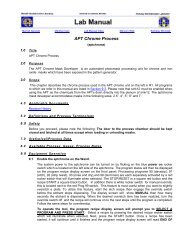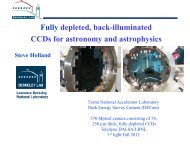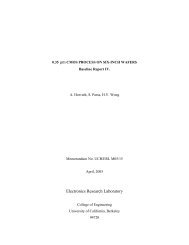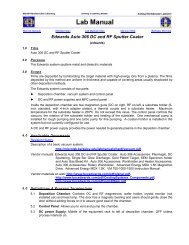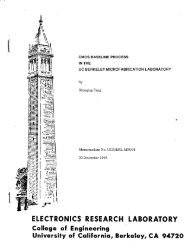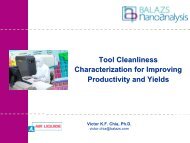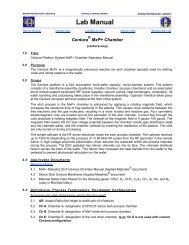Chapter 5 - TYLAN5 MOS Clean Gate/Dry ... - Berkeley Microlab
Chapter 5 - TYLAN5 MOS Clean Gate/Dry ... - Berkeley Microlab
Chapter 5 - TYLAN5 MOS Clean Gate/Dry ... - Berkeley Microlab
You also want an ePaper? Increase the reach of your titles
YUMPU automatically turns print PDFs into web optimized ePapers that Google loves.
Marvell Nanolab Member login Lab Manual Index Mercury Web <strong>Berkeley</strong> <strong>Microlab</strong><br />
1.0 Title<br />
<strong>TYLAN5</strong><br />
<strong>MOS</strong> <strong>Clean</strong> <strong>Gate</strong>/<strong>Dry</strong> Oxidation and Annealing<br />
Atmospheric Furnace (4” Only)<br />
(tylan5)<br />
<strong>TYLAN5</strong> <strong>MOS</strong> <strong>Clean</strong> <strong>Gate</strong>/<strong>Dry</strong> Oxidation and Annealing Atmospheric Furnace (4” Only)<br />
2.0 Purpose<br />
<strong>TYLAN5</strong> is an atmospheric furnaces that is designed for <strong>Gate</strong> oxidation, <strong>Dry</strong> oxidation and Nitrogen<br />
Annealing. The furnace accommodates wafers up to 4” in diameter.<br />
3.0 Scope<br />
This chapter covers the general furnace description of <strong>TYLAN5</strong>, TYCOM Terminal and operation<br />
procedures which include process recipe loading, wafer loading/unloading, user level problem<br />
diagnosis, and wafer cleaning requirements.<br />
4.0 Applicable Documents<br />
Revision History<br />
4.1 TYTAN Diffusion Furnace System Instruction Manual (copy in Office).<br />
4.2 TYCOM 9900 Microprocessor Control System Instruction Manual (copy in Office)<br />
4.3 Oxide Growth Chart, Semiconductor Technology Handbook (in the binder stored under TYCOM<br />
terminal)<br />
4.4 Material Safety Data Sheets for TCA (1,1,1-Trichloroethene), Oxygen, Nitrogen, and Forming<br />
Gas H2/N2 (copy in Lobby).<br />
5.0 Definitions & Process Terminology<br />
5.1 <strong>MOS</strong> Furnace: This kind of furnaces is used to fabricate <strong>MOS</strong> devices (IC), whose performance<br />
can be greatly impacted by trace contaminants. Wafers processed in a <strong>MOS</strong> furnace should<br />
absolutely be <strong>MOS</strong> compatible (IC device). Absolutely no metal film in any <strong>MOS</strong> Furnace, except<br />
the <strong>MOS</strong> sintering furnace, which allows only Al film.<br />
5.2 Non-<strong>MOS</strong> Furnace: The wafers processed in this kind of furnaces may contain materials that are<br />
not compatible with the <strong>MOS</strong> processes. If C<strong>MOS</strong> devices are processed in a Non-<strong>MOS</strong> furnace,<br />
the electric performance of the devices may be changed. Wafers with metal films can be<br />
processed in Non-<strong>MOS</strong> furnaces only with <strong>Microlab</strong> managerial permission.<br />
5.3 <strong>Dry</strong>/Wet Oxidation: A high temperature process that oxidizes the underlying silicon to form<br />
silicon oxide. <strong>Dry</strong> oxidation uses oxygen for better process control. Wet oxidation uses both DI<br />
water and oxygen for fast reaction rate.<br />
5.4 <strong>Gate</strong> Oxidation: A special dry oxidation process that produces high quality oxide with precise<br />
thickness control.
tylan5 <strong>Chapter</strong> 5.5<br />
5.5 Annealing: A high temperature process that uses nitrogen to keep wafers in an inert<br />
atmosphere. Major applications include dopant diffusion and activation, LTO/PSG densification,<br />
film stress release, and etc.<br />
5.6 TCA <strong>Clean</strong>ing: A high temperature process that uses TCA and oxygen to clean the furnace<br />
quartz parts and interior, by removing possible metallic contaminants in these areas.<br />
6.0 Safety<br />
Follow general safety guidelines in the lab as well as the specific safety rules as per follow:<br />
6.1 Electric Shock Hazard: TYLAN furnaces utilize high electric power (high amperages) to<br />
generate heat. Do not open the side panels or touch the high power electrical parts in the<br />
furnace cabinet.<br />
6.2 Chemical Hazard: TCA (1,1,1-Trichloroethene) is used for in-situ cleaning of quartz wares. It<br />
poses moderate health and high fire hazard. Please refer to the MSDS for first aid information.<br />
6.3 Burn Hazard. Cantilevers, boats, and wafers coming out of the furnace are very hot. Wear face<br />
shield when loading/unloading wafers. Proceed with caution. Avoid touching of any furnace<br />
quartz ware to prevent burning of your hands and contamination of the furnace. No flammable<br />
chemical, especially organic solvents, in the load station when the tube is open.<br />
6.4 All new recipes must be checked by the process staff, before they can be used on any TYLAN<br />
furnaces. Customized recipes should be stored on the user’s diskette, not the standard diskettes.<br />
7.0 Statistical/Process Data<br />
7.1 Problem and comment section under equipment section of the wand.<br />
7.2 Enable message for individual TYLAN furnace.<br />
8.0 Available Process, Gases, Process Notes<br />
Available Processes<br />
8.1 <strong>Gate</strong> Oxidation.<br />
8.2 <strong>Dry</strong> Oxidation (maximum temperature 1050ºC).<br />
8.3 Nitrogen annealing (maximum temperature 1050ºC).<br />
8.4 TCA clean.<br />
Available Gases<br />
8.5 Nitrogen (N2): Used to purge out room air and keep the process tube in an inert atmosphere.<br />
8.6 Oxygen (O2): Used for dry/wet oxidation.<br />
8.7 TCA (C2H3Cl3): Used for in-situ process tube cleaning.<br />
8.8 Nitrogen Carrier (N2cARR): Used to carry TCA vapor to the process tube.<br />
Process Notes<br />
8.9 Wafer cleaning requirements before loading into TYLAN furnaces (See also <strong>Chapter</strong> 5.0)<br />
8.9.1 Photo-resist on the wafer surface must be stripped first in PRS3000 bath of Sink5,<br />
Technics-C, or Matrix. Then cleaned in Sink8 (4”) piranha bath. New wafers can skip this<br />
step.<br />
8.9.2 All wafers then cleaned in Sink6 piranha bath. Wafers just unloaded from an <strong>MOS</strong><br />
furnace can be loaded into another furnace without further cleaning.<br />
8.10 Additional wafer requirement for the <strong>MOS</strong> furnaces: Only new wafers and wafers processed only<br />
in <strong>MOS</strong> clean furnaces can be loaded into a <strong>MOS</strong> furnace after cleaning. Wafers that have been<br />
- 2 -
tylan5 <strong>Chapter</strong> 5.5<br />
processed in a Non-<strong>MOS</strong> furnace or have gone through any Non-<strong>MOS</strong> processes can not be<br />
loaded into any <strong>MOS</strong> furnace. ABSOLUTELY NO EXCEPTION.<br />
8.11 No wafer processed with any metal films, even the film is stripped or covered, is not allowed in<br />
<strong>TYLAN5</strong>.<br />
9.0 Overall Furnace Operation<br />
9.1 General TYLAN Furnace Information<br />
The TYLAN Furnace consists of three basic modules: Load Station Module, Furnace Module, and<br />
Source Cabinet Module. <strong>Microlab</strong> members have access to the Load Station Module in the clean<br />
room area. The other two modules are in the Tylan service chase. Only <strong>Microlab</strong> staff with proper<br />
training has access to these two modules due to potential hazards.<br />
The Load Station Module houses a laminar flow unit with HEPA filter for clean air distribution. A<br />
Boat Loader Unit opens/closes the furnace door and pulls-out/pushes-in the cantilevers with<br />
wafer boats sitting on top. The operation can be automatically controlled by a process recipe, or<br />
manually using the ROP (see Section 9.3).<br />
The Furnace Module consists of a quartz process tube, thermal couples, and heating elements. It<br />
is divided into three zones: Load, Center, and Source. The temperature is controlled through a<br />
PID electronic board (DTC). All the control parameters can be set in the process recipe. The<br />
volume of the quartz tube is approximately 25 liters. The process gas flows into the tube from the<br />
Source end and vented through a hole on the Load end.<br />
The Source Cabinet Module contains several Mass Flow Controllers (MFC), which regulate the<br />
process gas flows, and the TCA bubbler.<br />
9.2 TYCOM Terminal<br />
The TYCOM Terminal controls/monitors all the TYLAN/TYSTAR Furnace operations. It consists<br />
of a CPU with two floppy disk drives, a CRT monitor and a keyboard. Disk drive #2, on the right<br />
side, is used for viewing and loading of recipes. The auxiliary drive is used for copying diskettes.<br />
The floppy disk used has a special format. All the standard <strong>TYLAN5</strong> recipes are store on the<br />
diskette labeled STANDARD DISK. Please ask staff if you need one to store your customized<br />
recipes.<br />
9.2.1 TYCOM commands – TYCOM CPU only recognizes CAPITAL letters only. You can use<br />
the numerical key pad on the right hand side of the keyboard to enter numbers. However,<br />
do not use the [Enter] key on the numerical key pad. It will cause error when loading a<br />
recipe.<br />
Commands Function Example<br />
DI DI<br />
Displays the recipe directory of the<br />
diskette in Drive #2<br />
DI RE recipe name<br />
Displays the content of a recipe on<br />
the diskette in Drive #2<br />
DI RE DRYOXA<br />
LO recipe name # Load a recipe to a TYLAN furnace LO DRYOXA<br />
DI ST #<br />
Displays current status of a TYLAN<br />
furnace (see Section 9.2.2)<br />
DI ST 5<br />
DI DE #<br />
Displays the system configuration of<br />
a TYLAN furnace<br />
DI DE 5<br />
DI AL #<br />
Displays previous process alarms of<br />
a TYLAN furnace<br />
DI AL 5<br />
- 3 -
tylan5 <strong>Chapter</strong> 5.5<br />
9.2.2 Display Furnace Status - When you use DI ST commands, the CRT monitor displays the<br />
status of the TYLAN furnace. This information is very important, especially for equipment<br />
problem diagnosis. The following example is used to explain the information users should<br />
know. The furnace status to be displayed is <strong>TYLAN5</strong> with recipe HIN2ANNL loaded but<br />
not running (Idle state).<br />
02/023/07 16:30:32<br />
*=DISABLED<br />
TUBE STATUS PROCID ET STEP TIME-TO-GO STEP ET<br />
005 READY HIN2ANNL 00:00:00 0000 00:00:00 00:00:00<br />
OUTPUTS RELAYOUT RELAYIN INPUTS<br />
N2 = 0.9 N2 = ON CCIN1 = OFF TEMPL = H 750.2 2118<br />
ANA02 = 0 CCOUT2 = OFF O2PRS = OFF TEMPC = G 750.5 0632<br />
O2 = .0 O2 = OFF CCIN3 = OFF TEMPS = G 749.5 0895<br />
N2CARR = .0 N2CARR = OFF CCIN4 = OFF CALIBL = 752.1<br />
ANA05 = .0 VENT = OFF CCIN5 = OFF CALIBC = 750.9<br />
ANA06 = .0 CCOUT6 = OFF BPIN = ON CALIBS = 747.3<br />
ANA07 = .0 CCOUT7 = OFF BPOUT = OFF<br />
ANA08 = .0 TCA = OFF CCIN8 = OFF<br />
TEMPL = 750.0 CCOUT9 = OFF N2 = G 0.9<br />
TEMPC = 750.0 CCOUT10 = OFF ANA02 = G .0<br />
TEMPS = 750.0 CCOUT11 = OFF O2 = G .0<br />
CCOUT12 = OFF N2CARR = G .0<br />
CCOUT13 = OFF<br />
DTCENA = ON<br />
LOAD = OFF<br />
UNLOAD = OFF<br />
The following sections explain the above display in details.<br />
Display Header (first 4 rows)<br />
The first row shows the current Data and Time stored in TYCOM CPU. The second row<br />
indicates that any INPUT or OUTPUT followed by an * on the display is disabled. None of<br />
the INPUT and OUTPUT of <strong>TYLAN5</strong> is disabled. On the third and fourth lines:<br />
TUBE - - - - - - - TYLAN furnace #.<br />
STATUS - - - - - READY (idle, recipe loaded but not running)<br />
RUN (recipe running)<br />
HOLD (recipe hold at certain step)<br />
STNBY (no recipe loaded, indicate power failure)<br />
PROCID - - - - - Recipe ID, stated in the first line of the recipe, usually the same as<br />
the recipe file name.<br />
ET - - - - - - - - - Total time elapsed since the process starts.<br />
STEP - - - - - - - Current recipe step.<br />
- 4 -
tylan5 <strong>Chapter</strong> 5.5<br />
TIME-TO-GO - -Time left to run in the current step.<br />
STEP ET - - - - Time elapsed in the current step.<br />
OUTPUTS – Process settings sent from TYCOM CPU to a TYLAN furnace.<br />
N2CARR, N2, O2 - - - - - - - - - - Process gas flow settings<br />
TEMPL, TEMPC, TEMPS - - - - Temperature settings for Load, Center, and<br />
Source Zone<br />
ANA0# - - - - - - - - - - - - - - - - - Available for future use.<br />
RELAYOUT – Commands sent to furnace Contact Closure Switches.<br />
N2CARR, N2, O2 - ----- Turn on/off the NUPRO valves of individual process<br />
gas. If off, no process gas flows regardless what the flow setting is.<br />
TCA - - - - - - - - When ON, N2CARR flows through the TLC liquid reservoir,<br />
then into the process tube, carrying the TLC vapor to clean the<br />
contamination. When OFF, N2CARR flow directly into the quartz tube without<br />
TLC.<br />
DTCENA - - - - Turns on the DTC board for furnace temperature control.<br />
Every recipe must have DTCENA=ON statement in step 0001.<br />
CCOUT# - - - - Available for future use.<br />
RELAYIN – Contact Closure Sensor inputs from a TYLA furnace to TYCOM CPU. When<br />
a process is running after the furnace door closes, only BPIN should be ON. All other<br />
RELAYIN should be OFF.<br />
O2PRSAL - - - - Low oxygen Pressure Alarm.<br />
BPIN/BPOUT - Boat cantilever at IN and OUT position.<br />
CCIN#- - - - - - - Available for future use.<br />
INPUTS – Actual Temperature and Gas Flow readings from furnace thermal couples and<br />
mass flow controllers.<br />
TEMPL, TEMPC, TEMPS - - - - -Actual temperature readings of Load,<br />
Center, and Source zones. A letter (H, G, L) in front of the temperature<br />
reading indicates whether the temperature is in the tolerance band set in the<br />
recipe. The 4-digits number, follows the temperature reading, represents<br />
electric power sent to each zone. The maximum power is 4095.<br />
CALIBL, CALIBC, CALIBS - - - - Calibrated temperature readings. If these<br />
readings differ from TEMPL, TEMPC, TEMPS by 2ºC, the process<br />
temperature may not stabilize. Report the problem on the WAND.<br />
N2CARR, N2, O2 - - - - - - - - - - Actual process gas flows. A letter (H, G, L)<br />
in front of the flow reading indicates whether the flow is in the tolerance band<br />
set in the recipe. If no tolerance is set, it is assumed that the tolerance is<br />
infinite, and the letter G appears all the time.<br />
9.2.3 Display Process Alarms – There is no special abort sequence for the TYLAN<br />
Atmospheric Furnace. To make sure that your process completes without any problem,<br />
the user should check the process run history by enter DI AL # command at TYCOM<br />
terminal. Due to the limited memory of the TYCOM CPU, the alarm history clears if the<br />
memory is full.<br />
- 5 -
tylan5 <strong>Chapter</strong> 5.5<br />
9.3 Remote Operating Panel (ROP)<br />
Every TYLAN furnace has a Remote Operating Panel (ROP) that is located next to its Load<br />
Station Module. The ROP is used to perform all the process operation after recipe loading at<br />
TYCOM terminal. It consists of two thumb wheels to control the boat loader speed, a LED display<br />
panel, several LED lights, and buttons. Their functions are explained in the following sections.<br />
9.3.1 Furnace Zone Firing LED –One the lower left corner of the ROP, there are three LED<br />
for three zones of the furnace. One flash on the LED means one electric current pulse<br />
flows through the heating element of the furnace zone.<br />
9.3.2 Boat Control – The process recipe can only ask for boat in and out but not the<br />
loading/unloading speed. The speed is set by the two thumb wheels located on the upper<br />
left side of the ROP. There are three buttons under the thumb wheels, (labeled IN, OUT,<br />
and STOP) that can be used to control the boat manually.<br />
9.3.3 Hardware Alarm – On the ROP, there are two more LED (Labeled OT and SCR). Both<br />
of them are hardware temperature control alarms. If either one is on, press the [Alarm<br />
Ack] button next to them to silence the alarm, then contact staff immediately. During nonoffice<br />
hours, abort process, then report problem on WAND.<br />
9.3.4 LED Display Panel and Numerical Pad – On the right side of the ROP, there is a LED<br />
display panel and a Numerical pad. The LED Display Panel cycles through the following<br />
furnace information when the [7|Status] button on the numerical pad is pressed.<br />
Process Status: READY Idle status, recipe loaded but not running (holding at step<br />
0001 of the recipe)<br />
END Process ends. Press [Alarm Ack] to silence the alarm and<br />
return to READY status.<br />
STNBY Standby status, recipe lost due to power failure or furnace<br />
computer reset. A recipe needs be loaded; otherwise the<br />
furnace cools down with all gases shut off.<br />
RUN A process recipe is currently running.<br />
Recipe Name: The Process ID that appears on the first line of the recipe. Usually the<br />
same as the recipe file name.<br />
STEP: The current step number of the running recipe.<br />
Time: Time to go in current process step (HH:MM:SS)<br />
Temperature: -Average temperature of the three furnace zones.<br />
Note: Do not press other numeric buttons which are designed for the industrial<br />
manufacturing use. If press by mistake, the LED display panel may not function<br />
properly. Press [Clear], then [7/Status] button to clear this problem.<br />
9.3.5 Process Operation Buttons – There are four buttons, on the right side of the ROP, for<br />
process control. Their function and corresponding TYCOM commands are listed in the<br />
following table.<br />
ROP button TYCOM command Function<br />
[Recipe|Run] RU # Run the loaded recipe<br />
[Hold|Clock] HO # Hold the process at current recipe step<br />
[Alarm|Ack] AC #<br />
Silence the process end alarm, returns the furnace to<br />
READY<br />
Skip to next process step (works only IF ALMACK=ON GOTO<br />
#### is in the current process step)<br />
[Abort] AB # Abort the current process, the furnace skip to END state<br />
- 6 -
tylan5 <strong>Chapter</strong> 5.5<br />
9.4 Available Recipes<br />
9.4.1 <strong>Gate</strong> Oxidation: SGATEOX<br />
9.4.2 <strong>Dry</strong> Oxidation: DRYOX<br />
9.4.3 Nitrogen Annealing: N2ANNLA, HIN2ANA<br />
9.4.4 Tube <strong>Clean</strong>ing: TCA<br />
9.5 Processing a Run<br />
Loading a Recipe<br />
9.5.1 Enable the TYLAN furnace.<br />
9.5.2 Check that no recipe is running in furnace and the ROP displays READY.<br />
9.5.3 Insert the recipe diskette for the furnace into floppy drive #2, right hand side, of TYCOM<br />
CPU.<br />
9.5.4 If you are not sure of the recipe name, enter DI DI at TYCOM Terminal to display the<br />
recipe directory.<br />
9.5.5 Enter LO recipe-name #, then press the [enter] key.<br />
9.5.6 Enter the process parameters when prompted. You can use the numeric key pad on the<br />
keyboard. But not the [enter] key on the right end of the numeric keypad. TYCOM does<br />
not recognize that key, and will not load the recipe.<br />
9.5.7 TYCOM Terminal displays RECIPE LOADED SUCCESSFULLY if there no error in the<br />
recipe and parameter entries.<br />
(Do not use TYCOM command RU # to start the process, because someone may be<br />
loading/unloading wafers on another furnace of the same bank. Besides, it is<br />
recommended that you check the ROP to make sure the recipe is loaded into the<br />
furnace.)<br />
Load wafers and run a process recipe<br />
9.5.8 Go to the front of the load station module of the TYLAN furnace. Press [7|Status] button<br />
on the ROP to make sure the furnace is at READY state and the recipe name is correct.<br />
9.5.9 Put on the face shield. Then press [Recipe|Run] button. The furnace door will open and<br />
the wafer boats come out. The door will close automatically after 20 minutes. If the boats<br />
start moving in and you need more time loading wafers, press [Alarm Ack] button on the<br />
ROP before the door closes, the boats will move out again and you have another 20<br />
minutes.<br />
9.5.10 Transfer your wafers from Sink6 to the furnace in a BLUE wafer box. See Section 8.9 for<br />
wafer cleaning requirement.<br />
9.5.11 Load <strong>MOS</strong> clean wafers using the <strong>MOS</strong> clean vacuum wand with red tubing. All the<br />
wafers should be loaded with flat up for better wafer support and consistency run-to-run<br />
results.<br />
9.5.12 Do not wear poly gloves over clean room gloves when loading/unloading wafers. The<br />
poly gloves usually are too big and slippery. The tips of the poly glove may melt on the<br />
hot quartz ware and cause contamination, which is hard to notice, because it is colorless<br />
and transparent. The poly gloves should be used at sinks and other room temperature<br />
operations only.<br />
9.5.13 After loading wafers, press [Alarm Ack] button on the ROP. The boat will start moving into<br />
the furnace. If you want to add/remove or reposition wafers before the door closes, press<br />
[Alarm Ack] once, the boat will move out again.<br />
- 7 -
tylan5 <strong>Chapter</strong> 5.5<br />
Unload wafers after process ends<br />
9.5.14 When the process reaches the last step, the ROP displays END and the alarm beeps.<br />
Press [Alarm Ack] button to silence the alarm and reset the furnace to READY state.<br />
9.5.15 To unload your wafers, press [Recipe|Run] button again, and the boats will move out.<br />
When the boats stop moving, wait a few minutes for wafers to cool down. Then use the<br />
appropriate vacuum wand to unload your wafers to the quartz boat on the cooling rack<br />
next to the furnace. The wafers may still be too hot for the plastic wafer box.<br />
9.5.16 Press [Alarm Ack] button to move the boats in. Press [Abort] button, then [Alarm Ack],<br />
and the furnace returns to READY state.<br />
9.5.17 Disable the TYLAN furnace on the WAND. Unload wafers from the cooling rack into<br />
wafer a box.<br />
10.0 Troubleshooting Guidelines<br />
10.0 TYCOM Terminal is blank<br />
10.0.1 Press [Enter] key. The terminal may be at sleep mode.<br />
10.0.2 Turn the terminal off, then on. This will reset the terminal. Adjust brightness/contrast if<br />
needed.<br />
10.0.3 If both of the above steps do not work, the TYCOM CPU needs reset (Section 10.2).<br />
10.1 Reset TYCOM Terminal<br />
10.1.1 Slide the TYCOM CPU out slowly.<br />
10.1.2 On the backside (up left corner facing the CPU), there is a black square power switch.<br />
Toggle the switch off then on.<br />
10.1.3 Check all the wires connected to the backside of the CPU are secured. Slide back the<br />
CPU slowly.<br />
10.1.4 On TYCOM terminal, Enter ACT PR, then [Enter].<br />
10.1.5 Enter IN DA dd/mm/yy; enter IN TI hh:mm:ss to set the date/time.<br />
10.2 I/O error – There is a communication problem between the TYCOM CPU and the furnaces.<br />
Report problem on WAND.<br />
10.3 Door will not open/Boat loader stuck<br />
10.3.1 Make sure there is nothing obstructs the movement of the boat loader.<br />
10.3.2 Make sure the cable that pulls the boat loader is not loose. If so, ask staff to adjust the<br />
tension of the cable.<br />
10.3.3 Try to move the boat loader manually. (Section 9.3.3)<br />
10.3.4 If the boat loader stuck on the track, give it a little pull/push help it overcome some<br />
friction. Do not use excessive force.<br />
10.3.5 If all the above step fail, report problem on WAND.<br />
10.4 OT/SCR alarm is ON – The furnace electronic board can not control the temperature. Silence the<br />
alarm. Find Staff immediately. During off hours, abort process and report problem on WAND.<br />
- 8 -
tylan5 <strong>Chapter</strong> 5.5<br />
TYLAN Atmospheric Furnace Study Guide<br />
Be sure to know…<br />
1. Maximum temperature.<br />
2. <strong>MOS</strong> vs. non-<strong>MOS</strong> rule.<br />
3. Loading and changing a recipe.<br />
4. TCA cleaning: when, why and how to do it.<br />
5. Troubleshooting the TYCOM screen.<br />
6. <strong>Clean</strong>ing wafers before they go into the furnace.<br />
7. Sending recipes to the furnace.<br />
8. Wafer loading into boats and into the tube.<br />
9. Displaying the status of a process.<br />
10. Unloading wafers and closing the tube.<br />
11. Which vacuum wand to use at which furnace.<br />
12. Alarms and what to do when you hear them.<br />
13. Preventing contamination in the VLSI.<br />
14. Positioning wafers in boats: why and how.<br />
15. Which furnace uses which gas(es).<br />
- 9 -



